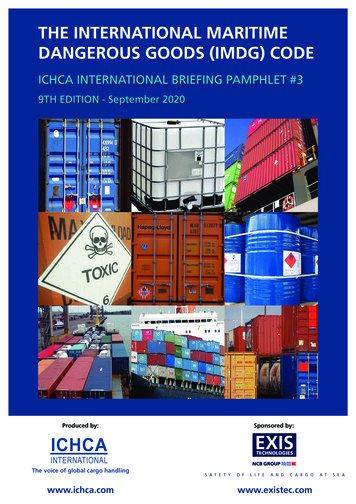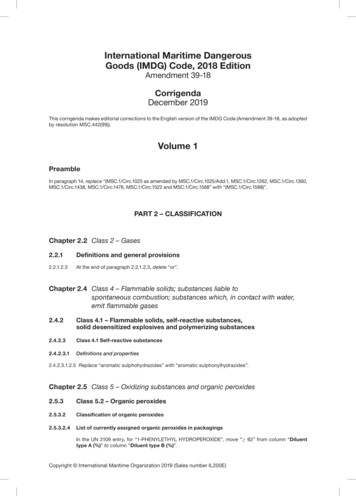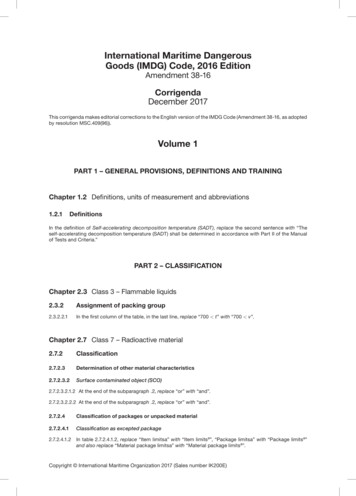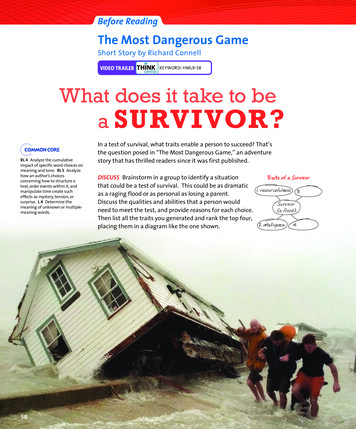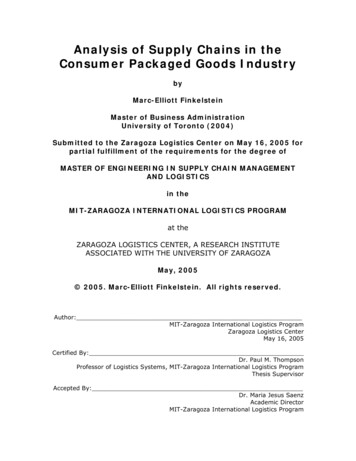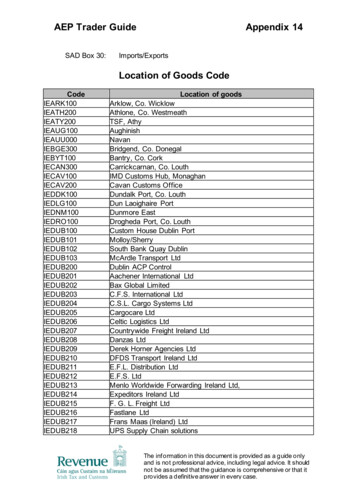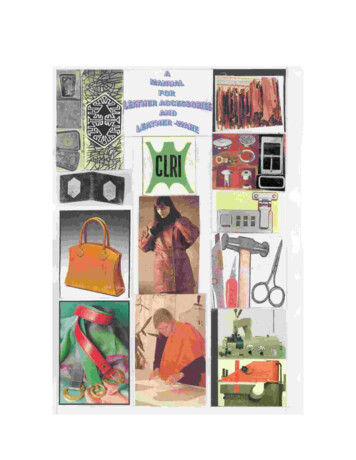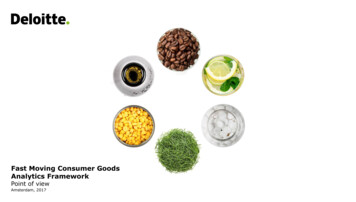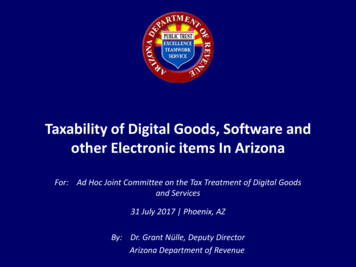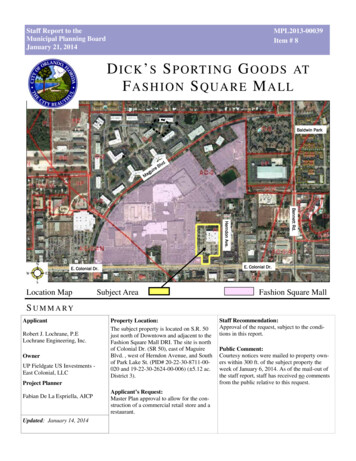
Transcription
PART 3DANGEROUS GOODS LISTANDLIMITED QUANTITIES EXCEPTIONS- 145 -
CHAPTER 3.1GENERAL3.1.1Scope and general provisions3.1.1.1The Dangerous Goods List in this Chapter lists the dangerous goods most commonly carried butis not exhaustive. It is intended that the list cover, as far as practicable, all dangerous substances ofcommercial importance.3.1.1.2Where a substance or article is specifically listed by name in the Dangerous Goods List, it shallbe transported in accordance with the provisions in the List which are appropriate for that substance orarticle. A "generic" or "not otherwise specified" entry may be used to permit the transport of substances orarticles which do not appear specifically by name in the Dangerous Goods List. Such a substance or articlemay be transported only after its dangerous properties have been determined. The substance or article shallthen be classified according to the class definitions and test criteria and the name in the Dangerous GoodsList which most appropriately describes the substance or article shall be used. The classification shall bemade by the appropriate competent authority when so required or may otherwise be made by the consignor.Once the class of the substance or article has been so established, all conditions for dispatch and transport, asprovided in these Regulations shall be met. Any substance or article having or suspected of having explosivecharacteristics shall first be considered for inclusion in Class 1. Some collective entries may be of the"generic" or "not otherwise specified" type provided that the regulations contain provisions ensuring safety,both by excluding extremely dangerous goods from normal transport and by covering all subsidiary risksinherent in some goods.3.1.1.3The Dangerous Goods List does not include goods which are so dangerous that their transport,except with special authorization, is prohibited. Such goods are not listed because the transport of somegoods may be prohibited for some modes of transport and allowed in others and, in addition, because itwould be impossible to draw up an exhaustive list. Moreover, any such list would soon cease to beexhaustive because of the frequent introduction of new substances; and the absence of a substance from sucha list might give the mistaken impression that that substance could be carried without special restrictions.Inherent instability in goods may take different dangerous forms, for example, explosion, polymerization,with intense evolution of heat, or emission of toxic gases. In respect of most substances, such tendencies canbe controlled by correct packing, dilution, stabilization, addition of an inhibitor, refrigeration or otherprecautions.3.1.1.4Where precautionary measures are laid down in the Dangerous Goods List in respect of a givensubstance or article (e.g. that it shall be "stabilized" or "with x% water or phlegmatizer") such substance orarticle may not normally be carried when these measures have not been taken, unless the item in question islisted elsewhere (e.g. Class 1) without any indication of, or with different, precautionary measures.3.1.2Proper shipping nameNOTE 1: For proper shipping names to be used for dangerous goods transported as limited quantities, see3.4.8.NOTE 2: For proper shipping names used for the transport of samples, see 2.0.4.- 147 -
3.1.2.1The proper shipping name is that portion of the entry most accurately describing the goods in theDangerous Goods List, which is shown in upper case characters (plus any numbers, Greek letters, 'sec', 'tert',and the letters m, n, o, p, which form an integral part of the name). An alternative proper shipping name maybe shown in brackets following the main proper shipping name [e.g., ETHANOL (ETHYL ALCOHOL)].Portions of an entry appearing in lower case need not be considered as part of the proper shipping name butmay be used.3.1.2.2When conjunctions such as "and" or "or" are in lower case or when segments of the name arepunctuated by commas, the entire name of the entry need not necessarily be shown in the transport documentor package markings. This is the case particularly when a combination of several distinct entries are listedunder a single UN Number. Examples illustrating the selection of the proper shipping name for such entriesare:(a)UN 1057 LIGHTERS or LIGHTER REFILLS - The proper shipping name is the mostappropriate of the following possible combinations:LIGHTERSLIGHTER REFILLS;(b)UN 3207 ORGANOMETALLIC COMPOUND or COMPOUND SOLUTION orCOMPOUND DISPERSION, WATER-REACTIVE, FLAMMABLE, N.O.S.*. Theproper shipping name is the most appropriate of the following possible combinations:ORGANOMETALLIC COMPOUND, WATER-REACTIVE, FLAMMABLE, N.O.S.ORGANOMETALLIC COMPOUND SOLUTION, WATER-REACTIVE,FLAMMABLE, N.O.S.ORGANOMETALLIC COMPOUND DISPERSION, WATER-REACTIVE,FLAMMABLE, N.O.S.each supplemented with the technical name of the goods (see 3.1.2.8.1).3.1.2.3Proper shipping names may be used in the singular or plural as appropriate. In addition, whenqualifying words are used as part of the proper shipping name, their sequence on documentation or packagemarkings is optional. For instance, "DIMETHYLAMINE AQUEOUS SOLUTION" may alternatively beshown "AQUEOUS SOLUTION OF DIMETHYLAMINE". Commercial or military names for goods ofClass 1 which contain the proper shipping name supplemented by additional descriptive text may be used.3.1.2.4Unless it is already included in capital letters in the name indicated in Dangerous Goods List,the qualifying word "LIQUID" or "SOLID", as appropriate, shall be added as part of the proper shippingname when a substance specifically listed by name may, due to the differing physical states of the variousisomers of the substance, be either a liquid or a solid (e.g. DINITROTOLUENES, LIQUID;DINITROTOLUENES, SOLID).3.1.2.5Unless it is already included in capital letters in the name indicated in the Dangerous GoodsList, the qualifying word "MOLTEN" shall be added as part of the proper shipping name when a substance,which is a solid in accordance with the definition in 1.2.1, is offered for transport in the molten state (e.g.ALKYLPHENOL, SOLID, N.O.S., MOLTEN).3.1.2.6Except for self-reactive substances and organic peroxides and unless it is already included incapital letters in the name indicated in the Dangerous Goods List, the word STABILIZED shall be added aspart of the proper shipping name of a substance which, without stabilization, would be forbidden fromtransport in accordance with 1.1.3 due to it being liable to dangerously react under conditions normallyencountered in transport (e.g.: "TOXIC LIQUID, ORGANIC, N.O.S., STABILIZED").When temperature control is used to stabilize such substances to prevent the development of any dangerousexcess pressure, then:- 148 -
(a)For liquids: where the SADT is less than 50 C, the provisions of 7.1.4 shall apply;(b)For gases: the conditions of transport shall be approved by the competent authority.3.1.2.7Hydrates may be included under the proper shipping name for the anhydrous substance.3.1.2.8Generic or "not otherwise specified" (N.O.S.) names3.1.2.8.1Generic and "not otherwise specified" proper shipping names that are assigned to specialprovision 274 in Column 6 of the Dangerous Goods List shall be supplemented with their technical orchemical group names unless a national law or international convention prohibits its disclosure if it is acontrolled substance. For explosives of Class 1, the dangerous goods description may be supplemented byadditional descriptive text to indicate commercial or military names. Technical and chemical group namesshall be entered in brackets immediately following the proper shipping name. An appropriate modifier, suchas "contains" or "containing" or other qualifying words such as "mixture", "solution", etc. and the percentageof the technical constituent may also be used. For example: "UN 1993 Flammable liquid, n.o.s. (containsxylene and benzene), 3, PG II".3.1.2.8.1.1 The technical name shall be a recognized chemical or other name currently used in scientificand technical handbooks, journals and texts. Trade names shall not be used for this purpose. In the case ofpesticides, only ISO common name(s), other name(s) in the World Health Organisation (WHO)Recommended Classification of Pesticides by Hazard and Guidelines to Classification, or the name(s) of theactive substance(s) may be used.3.1.2.8.1.2 When a mixture of dangerous goods is described by one of the "N.O.S." or "generic" entries towhich special provision 274 has been allocated in the Dangerous Goods List, not more than the twoconstituents which most predominantly contribute to the hazard or hazards of a mixture need to be shown,excluding controlled substances when their disclosure is prohibited by national law or internationalconvention. If a package containing a mixture is labelled with any subsidiary risk label, one of the twotechnical names shown in brackets shall be the name of the constituent which compels the use of thesubsidiary risk label.3.1.2.8.1.3 Examples illustrating the selection of the proper shipping name supplemented with the technicalname of goods for such N.O.S. entries are:UN 2003 METAL ALKYL, WATER-REACTIVE, N.O.S. (trimethylgallium)UN 2902 PESTICIDE, LIQUID, TOXIC, N.O.S. (drazoxolon).3.1.3Mixtures and solutions containing one dangerous substance3.1.3.1A mixture or solution containing a dangerous substance identified by name in the DangerousGoods List and one or more substances not subject to these Regulations shall be treated according to therequirements given for the dangerous substance provided that the packaging is appropriate to the physicalstate of the mixture or solution, unless:(a)The mixture or solution is specifically identified by name in these Regulations; or(b)The entry in these Regulations specifically indicates that it applies only to the puresubstance; or(c)The hazard class, physical state or packing group of the solution or mixture is differentfrom that of the dangerous substance; or(d)There is significant change in the measures to be taken in emergencies.- 149 -
3.1.3.2For solutions and mixtures treated according to the provisions given for the dangeroussubstance, the qualifying word "SOLUTION" or "MIXTURE", as appropriate, shall be added as part of theproper shipping name, e.g. "ACETONE SOLUTION". In addition, the concentration of the solution ormixture may also be indicated, e.g., "ACETONE 75% SOLUTION".3.1.3.3A mixture or solution containing one or more substances identified by name in theseRegulations or classified under a N.O.S. entry and one or more substances is not subject to these Regulationsif the hazard characteristics of the mixture or solution are such that they do not meet the criteria (includinghuman experience criteria) for any class.- 150 -
CHAPTER 3.2DANGEROUS GOODS LIST3.2.1Structure of the dangerous goods listThe Dangerous Goods List is divided into 11 columns as follows:Column 1'UN No.' - this column contains the serial number assigned to the article orsubstance under the United Nations system.Column 2'Name and description' - this column contains the proper shipping names inuppercase characters, which may be followed by additional descriptive textpresented in lowercase characters (see 3.1.2). An explanation of some of the termsused appears in Appendix B. Proper shipping names may be shown in the pluralwhere isomers of similar classification exist. Hydrates may be included under theproper shipping name for the anhydrous substance, as appropriate.Column 3'Class or division' - this column contains the class or division and in the case ofClass 1, the compatibility group assigned to the article or substance according tothe classification system described in Chapter 2.1.Column 4'Subsidiary risk' - this column contains the class or division number of anyimportant subsidiary risks which have been identified by applying the classificationsystem described in Part 2.Column 5'UN packing group' - this column contains the UN packing group number (i.e. I, IIor III) assigned to the article or substance. If more than one packing group isindicated for the entry, the packing group of the substance or formulation to betransported shall be determined, based on its properties, through application of thehazard grouping criteria as provided in Part 2.Column 6'Special provisions' - this column contains a number referring to any specialprovision(s) indicated in 3.3.1 that are relevant to the article or substance. Specialprovisions apply to all the packing groups permitted for a particular substance orarticle unless the wording makes it otherwise apparent.Column 7'Limited quantities' - this column provides the maximum quantity per innerpackaging authorized for transport of the substance concerned according to theprovisions for limited quantities in Chapter 3.4. The word "None" in this columnmeans that the article or substance is not permitted to be transported under theprovisions of Chapter 3.4.Column 8'Packing instruction' - This column contains alpha numeric codes which refer to therelevant packing instructions specified in section 4.1.4. The packing instructionsindicate the packaging (including IBCs and large packagings), which may be usedfor the transport of substances and articles.A code including the letter "P" refers to packing instructions for the use ofpackagings described in Chapters 6.1, 6.2 or 6.3.A code including the letters "IBC" refers to packing instructions for the use of IBCsdescribed in Chapter 6.5.A code including the letters "LP" refers to packing instructions for the use of largepackagings described in Chapter 6.6.- 151 -
When a particular code is not provided, it means the substance is not authorized inthe type of packaging that may be used according to the packing instructionsbearing that code.When N/R is included in the column it means that the substance or article need notbe packaged.The packing instructions are listed in num
- 148 - 3.1.2.1 The proper shipping name is that portion of the entry most accurately describing the goods in the Dangerous Goods List, which is shown in upper case characters (plus any numbers, Greek letters, 'sec', 'tert',
